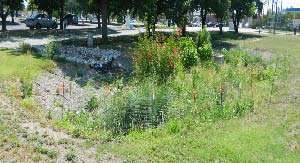Stormwater practices at Texas A&M AgriLife Dallas center show statewide, broader promise

The results of stormwater practice demonstrations at the Texas A&M AgriLife Research and Extension Center in Dallas demonstrate the potential benefits for using such practices in urban areas statewide, an expert said.
"Because much of the land in urban areas is paved or covered by other impervious structures, typical filtration and purification done by soil and plants has been sidestepped," said Dr. Fouad Jaber, Texas A&M AgriLife Extension Service specialist in integrated water resources management. "So bacteria, sediments, oil, grease and chemicals from yards, roads and parking lots and elsewhere end up running off directly into watershed areas."
Jaber said to help address this problem, he has been testing low impact development practices, including permeable pavements, green roofs and a bioretention-rain garden area.
Low impact development, or LID, is a stormwater management approach using innovative planning and engineering in concert with conservation and nature to protect water quality. In testing these practices at the center, Jaber established methods to monitor and measure their effects on hydrology, nitrogen, phosphate, total suspended solids, bacteria and other pollutants.
Evaluation was done in a field setting with soil comparable to that of the Blackland region and much of the southern U.S.
"Up until now, there hasn't been much data to show how adopting LID practices on a watershed scale in urban areas may help reduce flooding and improve overall water quality," Jaber said. "Now, after two years of testing, we have initial data demonstrating the value of these practices."
Jaber said data gathered from early 2013 to the end of March 2015 and applicable to the Upper Trinity-White Rock Creek Watershed would also translate to other urban U.S. watersheds.
"What we found was that if there was a rain event of 1.5 inches or less, which is typical in this area, by using these practices, 50 percent of the water stays in the soil and either infiltrates or evaporates, 40 percent leaves through a drainage pipe after being filtrated by the soil and only 10 percent overflows untreated."
One of Jaber's tests was to determine how effective permeable pavement would be in reducing runoff water volume and pollutants. In a simulated parking lot area at the center, he installed various pavement types, including interlocking concrete blocks, grass pavers, pervious concrete, permeable asphalt and regular concrete.
Twenty-five experimental stalls, each measuring 8 feet by 10 feet, were installed among 52 total functional stalls. Each permeable pavement was 16 inches thick with a gravel layer and perforated under-drain pipes. Stalls were hydrologically separated by concrete curbs.
"Our data showed a stormwater runoff reduction rate of 71 percent for permeable interlocking concrete pavers, 74 percent for pervious concrete, 78 percent for grass pavers and 93 percent for gravel pavers," Jaber said. "Additionally, there was a 57 percent reduction in total suspended solids in the pervious concrete and a 48 percent reduction in total suspended solids in the gravel pavers. Nitrate and orthophosphate concentrations were also generally low."
At another center site, Jaber has been testing green roofs—roofs covered by a growth medium and planted with vegetation—each with a waterproof membrane, root barrier and drainage area. The site has four green roofs, each 100 square feet in area and divided into four sections, with three of the roofs covered with native North Texas plants.
"For a 1.5 inch rainfall, 77 percent of runoff comes from the house and 23 percent comes from the lawn. The average load in one milliliter of ambient water is 2,098 E. coli count. Due to the volume reduction from the green roofs, the average load per millimeter for the entire house would be 485, which would be a 77 percent reduction in the amount of E. coli bacteria."
At another site, a bioretention-rain garden area collects runoff from a 37,000-square-foot parking lot at the center. Using 4 feet of a mixed medium, the retention area has been populated with native plants. A 4-inch perforated pipe has been placed at the bottom for drainage. An adjacent rain garden bed is planted with perennial and annual natives to promote water absorption and filtration.
Jaber said data from the past two years shows the bioretention-rain garden area has provided an average of a 45.52 percent reduction in stormwater runoff. It also shows it was responsible for a 78 percent reduction in nitrogen, 36 percent reduction in orthophosphate, 41 percent reduction in total phosphorus, 66 percent reduction in ammonium, 64 percent reduction in total Kjeldahl nitrogen—the total concentration of organic nitrogen and ammonia - as well as an 83 percent reduction in total suspended solids.
"The large number of storms that occurred in Texas in March through May resulted in flooding that caused loss of life and property damage across the state," Jaber said. "And while individual storm events were not very large, the frequency of these events was very high. This saturated the soils and caused flash flooding from even small subsequent rain events."
He said despite the fact that LID practices at the Dallas center were designed to handle small rain events, during this three-month time period they were able to prevent a large portion of the water runoff from leaving the property.
"From Feb. 28 to May 30, the center received approximately 23 inches of rain," he said. "Approximately 84 percent of the total runoff that entered the LID practices was held in the soil and eventually percolated or evaporated. Only 16 percent of the total runoff left the property."
Jaber said these results show that if similar practices were widely adopted in Texas cities, the loss of life and property from frequent rain events could be considerably reduced.
Provided by Texas A&M University


















